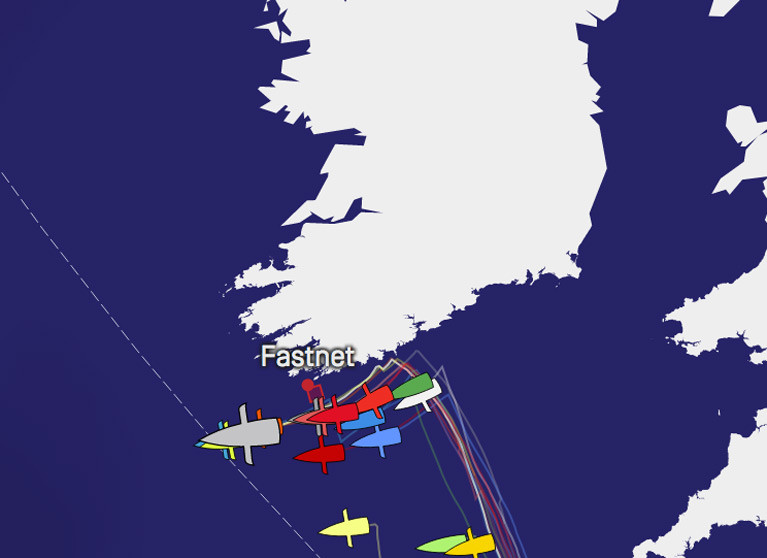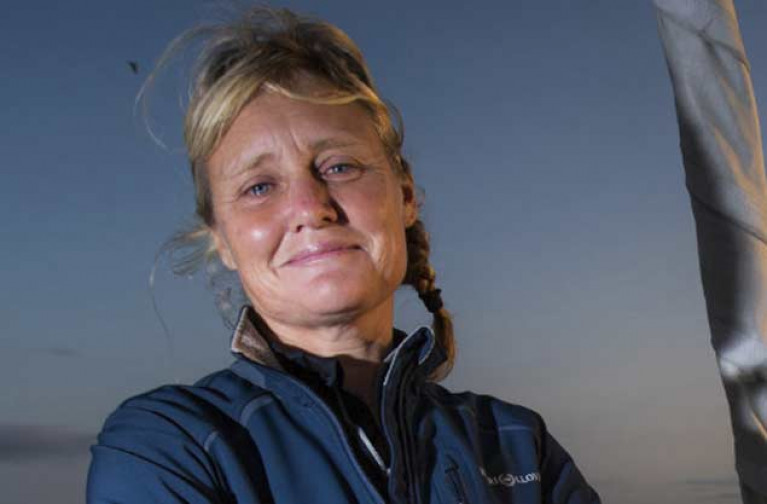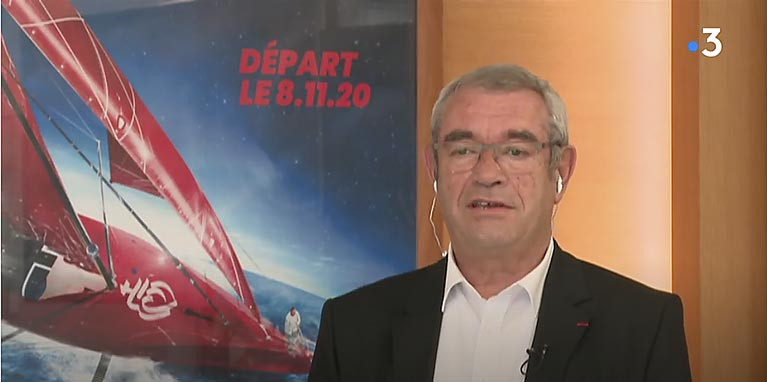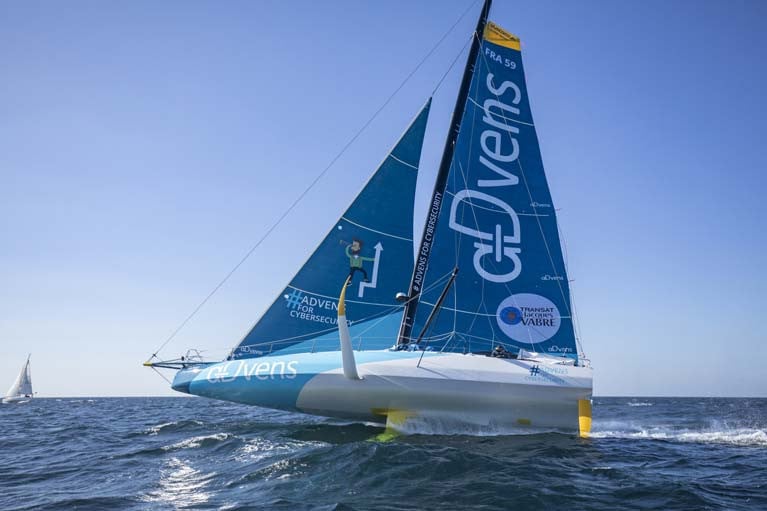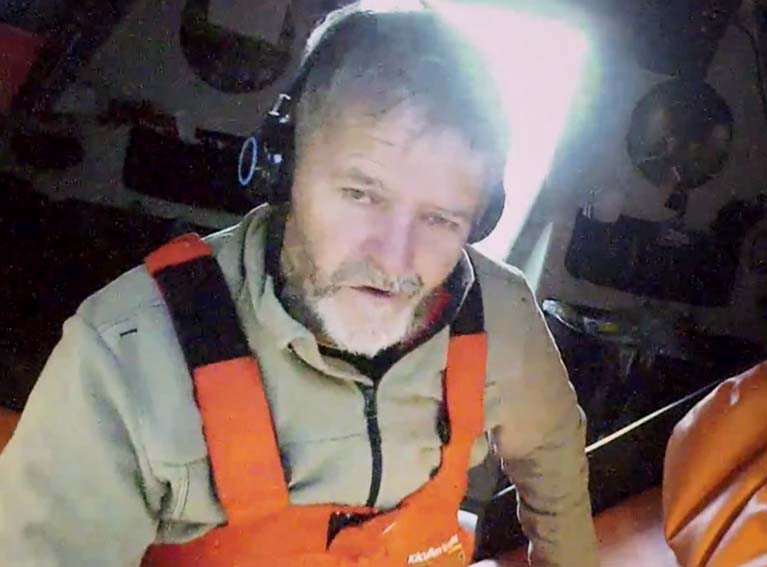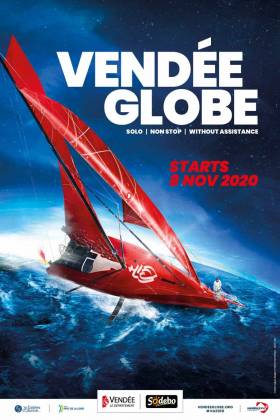Displaying items by tag: Vendee Globe
Vendee Arctique Fleet Navigate West Cork Coast
It was a tough night off Ireland in the Vendee-Arctique- Les Sables d'Olonne as an international fleet of racers navigated the West Cork coast.
During their second night at sea, on their way from Les Sables d'Olonne to Iceland, the fleet has been closing on the southwest corner of Ireland with the leaders coming within a couple of miles of the coast near Kinsale in a bid to get out of the worst of the weather.
It has been a long hard beat into the northwesterly wind which has been hitting 35 knots in the gusts. Throughout, the leader has remained the Frenchman Thomas Ruyant on LinkedOut (managed by Ireland's Marcus Hutchinson), the boat named after a charity supporting the homeless.
 French sailor Thomas Ruyant on LinkedOut Photo via IMOCA Global Series
French sailor Thomas Ruyant on LinkedOut Photo via IMOCA Global Series
He has set a tough pace for the leading group which has settled into a collection of four boats with Charlie Dalin on Apivia this morning in second place just one-and-a-half nautical miles behind, then Jeremie Beyou on Charal (+2.5) and Kevin Escoffier on PRB (+3.9) in fourth place.
At a position about 45 miles south of the Fastnet Rock on starboard tack, Ruyant was pushing his foiler ahead at 14 knots with about 800 miles to go to reach the IOC UNESCO waypoint off the southwest tip of Iceland.
"Ruyant was pushing his foiler ahead at 14 knots with about 800 miles to go to reach Iceland"
The last 24 hours have seen a second boat return to port with Damien Seguin following the earlier example of Sebastien Simon (ARKÉA PAPREC) deciding to head for Port-La Forêt on board Groupe APICIL.
Seguin discovered that his alternator mounting had completely sheered off in the upwind conditions that were battering his boat and realised he would not have enough power to run his onboard systems without being able to use the engine.
"I quickly looked at what I could do and realised that unfortunately, I couldn't fix it at all," said Seguin who has never retired from a professional race before. "It seemed very difficult to continue like this upwind without being able to re-charge the batteries on board, so I made the decision with the team to return to Port-La-Forêt," he added.
Seguin was just south of Brest this morning on his way home but had not retired from the race.
Alex Thomson has returned to the water onboard HUGO BOSS, the boat which he hopes will lead him to victory in the 2020 Vendee Globe.
Thomson who has strong links to Cork Harbour and is a former Afloat Sailor of the Month now has less than five months to go until the start of the round-the-world endeavour, dubbed the Everest of the Seas.
Thomson and his team - much like their competitors in the IMOCA class - were unable to train on the water for some 9 weeks due to the COVID-19 pandemic. Following the easing of lockdown restrictions in England, however, the team have been able to return to the water to commission the yacht, before re-commencing their training.
The news comes as organisers of the Vendee Globe this week confirmed that the race - which takes place just every four years and is considered the pinnacle event in the offshore sailing calendar - will indeed go ahead as planned on 8th November from Les Sables-d’Olonne in western France.
With less than five months to go until the start of the round-the-world endeavour, Thomson has made clear the team’s sole focus over this period will be maximising their time on the water and optimising the performance of the HUGO BOSS boat.
Over the coming weeks and months, Thomson and his crew will train offshore in a bid to further develop and enhance the performance of the HUGO BOSS boat, which launched in the summer of last year after more than two years in design and build. Thomson will also complete his solo 2,000 nautical mile passage, a final qualification requirement for the Vendee Globe.
“We feel in really good shape” he continued. “Of course, like all the teams, we’ve lost time on the water but that was out of our hands. The team has adapted well and we’ve really made the most of this period. Now it’s about putting the knowledge we’ve gained - and projects we’ve worked hard to develop - to the test. We’re now a few days into our training and I’m very pleased with the decisions that we’ve made so far. HUGO BOSS is performing very well indeed!”
The Visually Impaired Sailing Association (VISA-GB) today announced that Pip Hare the respected sailor and Vendee Globe competitor has become the Patron of the Association.
VISA-GB is unique amongst disabled sailing charities because the majority of its board of trustees are visually impaired sailors who give a significant amount of their time to create opportunities for others with a visual impairment, to experience the freedom of offshore sailing. The majority of the crew on VISA-GB boats are normally visually impaired and play a full role in sailing and running the yacht.
Eddie Kitchen, chairman of VISA-GB said of Pip’s appointment: "All of us at VISA are thrilled that Ocean racer, and lifelong sailor, Pip Hare has agreed to be our Patron. Our charity will benefit from her enthusiasm, knowledge and determined attitude that will see her on the start line if this year's Vendee Globe race. Pip embodies much of what we stand for, there are many that think we chase impossible dreams, but our blind and visually impaired members are determined not to allow a lack of sight to stop them enjoying and benefiting from sailing. As our figurehead we know Pip will encourage us to achieve our ambitions.”
He added “I also know that Pip will help us to deliver our message to all in the visually impaired and blind community and that VISA-GB will continue to empower our sailors, encourage all to learn new skills and enjoy their participation in our great sport."
When asked about her new role Pip said "I was delighted to be approached by the Visually Impaired Sailing Association with a view to become their Patron. Having met some of the
VISA-GB sailors in 2019 I was extremely impressed by their approach and felt it matched my own. By empowering the visually impaired sailors to manage the complete boat trip it created a wonderfully positive approach to sailing. My own goals have been achieved by the same single-minded determination I saw in these sailors, and I found it inspirational. By
making sailing more accessible and fully inclusive I firmly believe we can make our sport open to all. I am pleased to accept the post of Patron and ambassador for VISA-GB and look forward to supporting and helping them achieve their goals."
With a full programme of events planned for 2021, VISA-GB hopes to have over 100 visually impaired sailors on the water, both cruising and racing. They are currently planning for a circumnavigation of the UK to offer a taste of life on the water to the visually impaired in all corners of the country. Trustees and members will be following and supporting Pip on her adventure in the Vendee Globe.
2020 Vendee Globe Will Start On 8th November
Preparations for the start of the next Vendee Globe are going ahead in an uncertain context in terms of public health and the economy. The Vendee Council and the SAEM Vendee are doing their utmost in conjunction with all the partners, skippers from the IMOCA Class, their sponsors and public authorities to ensure arrangements for this ninth edition of the Vendee Globe go smoothly.
Maintaining the start date of 8th November for the race is the goal and everything is being done to achieve that.
In terms of racing, nothing prevents the race from starting on 8th November, as long as the national authorities allow that to be the case. However, for the Vendee Globe, which is a popular event and belongs to the local people, the presence of the public is important for us.
The organisers are therefore studying every possible situation to be able to welcome the public at an event like this in the economic and public health context, the evolution of which is hard to predict. The decision to keep Race HQ in Les Sables d'Olonne throughout the whole race will in fact help to ensure a maximum number of people can fully enjoy the Vendee Globe adventure.
At the same time, the Vendee Globe organisers are working in conjunction with the IMOCA Class towards the goal of adapting some of the deadlines for the skippers, in particular, the final date for registrations which has been pushed back until 1st September and the organisation of a preparatory solo race this summer.
A race from Vendee-Arctic-Les Sables d'Olonne to take place in July
At the same time, the Vendee Globe organisers are working in conjunction with the IMOCA Class towards the goal of adapting some of the deadlines for the skippers, in particular, the final date for registrations which has been pushed back until 1st September and the organisation of a preparatory solo race this summer.
With sailing gradually starting again, the IMOCA Class has been working over the past few weeks on organising a preparatory race, which was initially scheduled for June. In agreement with the Vendee Department, the headline partner for the event, the IMOCA Class proposed a race starting from off Les Sables d'Olonne on 4th July. This will be a solo race taking the sailors up past Iceland and into the Arctic Circle and then down to the Azores with a return to the start location planned around ten days later.
Vendee Globe solo round the world race boss said this week a 'final decision' will be made about the November start of France's 'Everest of sailing' next month due to COVID-19 concerns.
Yves Auvinet, chairman of the SAEM Vendée told France 3 Television on Tuesday (May 5) that a decision will be made in collaboration with the IMOCA class and SAEM Vendée around June 15.
A qualifying race is scheduled to start in the French Port of Les Sables-d'Olonne on July 4.
Although the Round the World race is entirely solo and unassisted, thousands of spectators are involved in November send off from Les Sables-d'Olonne and as Afloat reported previously, Auvinet said in April “The technical and sporting preparations for participants have been severely impacted by this unprecedented crisis".
The latest interview (in French) is below
Two solo transatlantic races initially planned for the Globe Series championship this spring should have allowed some skippers to qualify and others to test their monohull after winter modification work but were cancelled.
November's Vendee Globe Solo Round the World Race is Go!
The health crisis that has shaken society for the last month is forcing those who are involved in the worlds of sports and business to adapt amidst this period of uncertainty. The French President’s address on 13th April did, however, lay the foundations for an exit strategy from this global pandemic and suggests a possible recovery period from the middle of July. As things stand today, the Vendée Globe is to remain on course with the race due to start from Les Sables-d'Olonne on 8th November.
Yves Auvinet, president of SAEM Vendée said: “The technical and sporting preparations for participants of the solo non-stop yacht race around the world without assistance have been severely impacted by this unprecedented crisis. We are very aware of this. For several weeks now, SAEM Vendée has been in very regular contact with skippers and all the key players of the Vendée Globe, to discuss these issues and propose solutions. Our aim is for the ninth edition of the race to start on the 8th November in the best possible conditions, while remaining very attentive to developments of the situation.
The two solo transatlantic races initially planned for the Globe Series championship this spring should have allowed some skippers to qualify and others to test their monohull after winter modification work.
The IMOCA class and the department of Vendée, a major partner in the race, are working to finalise an alternative to the New York - Vendée Les Sables-d'Olonne, a dress rehearsal before the Vendée Globe and therefore an essential race allowing for the skippers to prepare. Its format will be revealed soon.
Meanwhile, the Vendée Globe organisers are keeping a close eye on the health crisis linked to Covid-19 and any repercussions it may have.
Following the spread of the Covid-19 Coronavirus, the SAEM Vendée in France has decided to cancel the press conference for the Vendée Globe which was scheduled to take place in Paris this coming Tuesday 10th March.
The organiser of the Vendée Globe round the world race is applying the precautionary principle in compliance with the government’s recommendations which prompt to limit broad public meetings in a confined space whenever possible.
The next major press conference will take place on the 17th of September, at the Palais-Brongniart in Paris.
As regular Afloat readers will know, every four years, an elite group of sailors endeavour to sail single-handed, non-stop in a circumnavigation of the planet, through the most unpredictable and perilous conditions imaginable. They are competitors in the Vendee Globe – one of the most arduous, challenging and dangerous events in sport.
These sailors know the real adversaries are the waves and the weather, the ice and isolation. The last race had an Irish skipper competing for the first time, as Irish Entrepreneur, Author and Business Post Publisher Enda O’Coineen sailed the Kilcullen Voyager into the history books.
But this grand solo voyage did not go to plan...
At 1745 hrs this Sunday, January 5, Virgin Media THREE are broadcasting the Journey to the Edge Documentary on Enda's feat.
Check out the (three minute) trailer below:
Purchase Enda's book on the voyage and much more directly from the Afloat site here
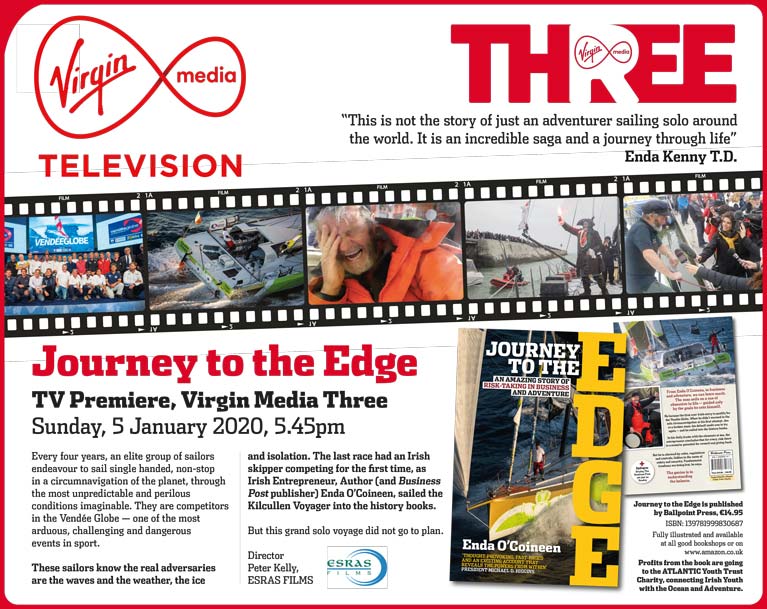
New Vendee Globe Race Poster Evokes Spirit of Adventure
The just-unveiled Vendée Globe Race poster is as epic as the world-girdling French event it seeks to represent.
With the presence of the foils clearly visible and a solo skipper perched at the bow of the boat, the poster aims to reflect the technical evolution of the competing boats.
Organisers say that the visual, designed by the Désigne and Pulp agencies, offers a 'dreamlike identity' in which the race’s main themes are conserved, the planet’s oceans, the emblematic colours of the race, red and blue, and the solo skipper at bow of the boat.
Vendée Globe 2020: 37 Candidates, 34 Places (But No Irish)
The ninth edition of the Vendée Globe will start from Les Sables d’Olonne on Sunday the 8th of November 2020. There are finally 37 candidates hoping to be at the start of the next Everest of the Seas race but after some intense interest and declarations, no Irish campaigns will make the start line.
Just a few years back ago, there were as many as four Irish solo sailors with campaigns intent on following in Enda O'Coineen's wake to become the first Irish sailor to complete the world-girdling course but after a rigorous application process, none are in the final line up.
In 2017, the Galway Bay sailor made history when he became the first Irish sailor to make the Vendee start in the gruelling non-stop single-handed race around the world but lost his mast and retired off the New Zealand coast.
It's all been enough to prompt Afloat's WM Nixon to ask if the Irish lost the run of themselves aiming for the Vendee Globe?
Four years later, however, there is no shortage of interest regardless of the Irish no show but hope lives on for an Irish 2024 campaign.
The 2020 edition of the race already promises to be very rich : nine new boats, a real confrontation between shipyards, half of the fleet equipped with foils, a record number of nationalities at the start, six women candidates, a great champion in disabled sports, and the return of the unmissable leading figures in off-shore racing.
This 2020-2021 vintage should be exhilarating and proves more than ever that the Vendée Globe is a real sporting and human adventure.
As announced by the President of the Race, Yves Auvinet, during the 1st skipper briefing on the 3rd of October, only 34 of them will be able to take the start on the 8th of November 2020.
Details are here


























